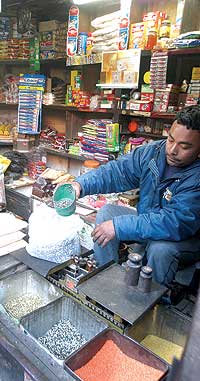 Fifty years ago, a Japanese agricultural consultant arrived in Nepal to advise farmers on the latest agricultural techniques. He returned home earlier than anticipated, saying there was nothing he could teach Nepali rice farmers.
Fifty years ago, a Japanese agricultural consultant arrived in Nepal to advise farmers on the latest agricultural techniques. He returned home earlier than anticipated, saying there was nothing he could teach Nepali rice farmers. The production of rice was good, the taste even better, and entire families sustained themselves using traditional methods to plant an astounding variety of rice: Gudgude Marsi, Thauli, Mansara, Anadi, Rajbhog, Krishnabhog, Samundra Pheenz, Phalame.
At Nepal Agricultural Research Council (NARC) Bhola Man Singh Basnet, says this year Nepal has recorded the highest yield ever: 2.9 tons per hectare. But 79 percent of the rice fields grow high-yield hybrid rice, which means local varieties are being driven out. The International Rice Research Institute (IRRI) in the Philippines preserves 1,800 local Nepali rice germplasm in a refrigerated earthquake-proof vault. The gene bank includes the rich Tilki from Dang and the aromatic Jetho Budo from Pokhara.
"Local varieties are important because they are disease, drought and insect-resistant," explains Basnet. IRRI's Green Revolution rice provides higher yield, but lack the adaptability of local seeds.
In Kathmandu, some of the more popular improved varieties found in the market include Khumal-4, a fine non-glutinous rice and Manjushree-2, another popular fine rice. Thaichung-176 is a glutinous rice very popular in Kathmandu, particularly among the Newars to make chiura and jand. Nepalis prefer the less sticky non-glutinous rice because it is easier to eat with the fingers.
Those eager to sample Nepali rice needn't worry. It's Binita Khanal's business to know where local varieties are grown and make them available to Kathmandulays through her direct selling Bazar Enterprises Network which provides pulses, tea, oil, spices, rice and more bought directly from the producers.
There are four main Nepali rice found in Kathmandu: Mansuli, Pokhrali, Jeera Maseeno and several varieties of Basmati. The most popular is Mansuli which is cheaper with higher yields. Pokhreli and Jeera Maseeno are more popular among the middle- and higher-middle class, while Basmati varies according to quality. Khanal's personal favourite is Jeera Maseeno: "It's good for my entire household, my employees and my children alike. We all eat the same quality of rice and Jeera Maseeno is average."
Her own experience has been that rice grown in the belt spanning Sundarijal to Panauti tastes best. To those who want to sample different varieties of rice, the old quarter of Asan and Mangal Bazar have a lot to offer. The ancient shops sell an astounding variety of rice piled into old oil tins, and the vendors will guide you through the properties of each rice.
(Sraddha Basnyat)


